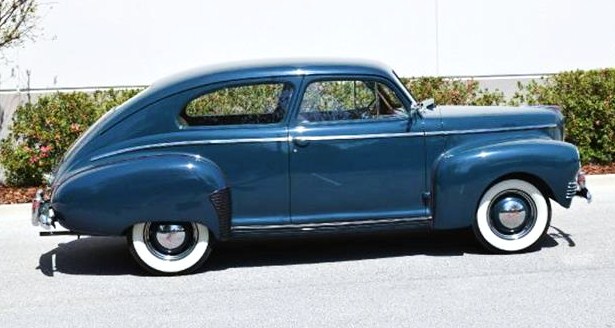
When most people think of the late, lamented Nash brand, they conjure up bulbous family cars of the 1950s or perhaps the tiny Nash Metropolitan. Few picture the stylish, forward-looking cars that Nash created in the pre-war years.
Here’s one of my favorites for Pick of the Week, the cheeky 1941 Nash Ambassador that took the common look of production-car styling and gave it a streamlined tweak that makes all the difference.

“The aerodynamic design was referred to as slipsteam styling – sleek and smooth for the day with no protruding lights, running boards or door hinges,” the Orlando, Florida, seller states in the ClassicCars.com advertisement.
The two-door Nash has a great look, hunkered forward in an athletic stance that seems like it’s always pushing against the wind, almost cartoonish in a way, but very appealing for anyone who appreciates this era of American sedans.
And there is a historic element to its design: “The 1941 Nash is also recognized as the first mass-produced American car to utilize unibody construction,” the seller says.
The Nash is powered by a 176-cubic-inch inline-six-cylinder engine that produces 82 horsepower. The engine is linked to a three-speed manual transmission, according to the seller, who notes that the car gets 30 miles per gallon, giving it a 600-mile cruising range from its 20-gallon gas tank.
The Nash is priced at $22,900, which would get you a unique piece of vintage motoring that would stand out at the cruise-in among all the Chevys, Fords and Plymouths.
“This is a beautiful example with excellent paint, body and chrome,” the seller says. “This Nash runs and drives excellent!”






Unfortunately, this model is not an Ambassador. In 1941, model designations were the “600” model of which this is, and the “800” which also was known as the Ambassador.
Viewing this illustration, you see the rear fender bottom line covers most of the upper half of the tire and that was representative of the “600” model. The “800” rear fender was a fully open cut fender, and had a larger body. This particular example here is really a good looking model. My family had a regular 4 door sedan “600”. It was a great car also.
Thanks for the comment, Jay. From my research, I found that this model is indeed named Ambassador, in this case the Ambassador 600 designating the smaller model of 1941. There were also larger models known as the Ambassador 6 and Ambassador 8, powered by 6- and 8-cylinder engines, respectively. I could not find any mention of an 800 model. But whatever it’s name, I really like this car and wouldn’t mind owning it.
you are right my father worked for Nash, there was no model as the 800. after the war the 1946 was named the 600 and the Ambassador until 49 when the models were Statesman and Ambassador, the statesman had a flat head 6 cyl and the ambassador had an overhead 6cyl,same type of engines in 41,but a flat 8 was still available and then dropped
I will stand corrected regarding the “800” designator. However, I have that “800” designation so imbedded in my brain (which my wife says I don’t have) that I cannot figure out why. Our family had a ’41 600, ’48 600, ’50 and ’51 Ambassadors, and a ’53 Ambassador. They were all excellent automobiles. And Nash led the way to many new features in auto design. It is a shame that Nash did not survive. I still have the owners manual for the ’51.
This is NOT an Ambassador. The Ambassador has the larger overhead valve engine and a longer wheelbase. The 600 has the under-powered 82 hp. flathead six that gets 30 mpg in overdrive. There is a huge difference between an Ambassador and a 600–ask any Nash Club member.
Pete Phillips, Nash Club member #7399
1954 Ambassador Custom Country Club hardtop
1954 Ambassador Custom Lemans Country Club hardtop
Leonard, Texas
i had a 41 for about a minute in the mid sixties..a guy sold it to me for twenty bucks then got himself killed at a rail crossing in kansas,, the car set at a filling station for over twenty years..no title and locked up in an estate. i had to abandon the Nash finally unable to get a clear title,,some years later the station closed, the car vanished and that is that..i sure wanted that car but to no avail.